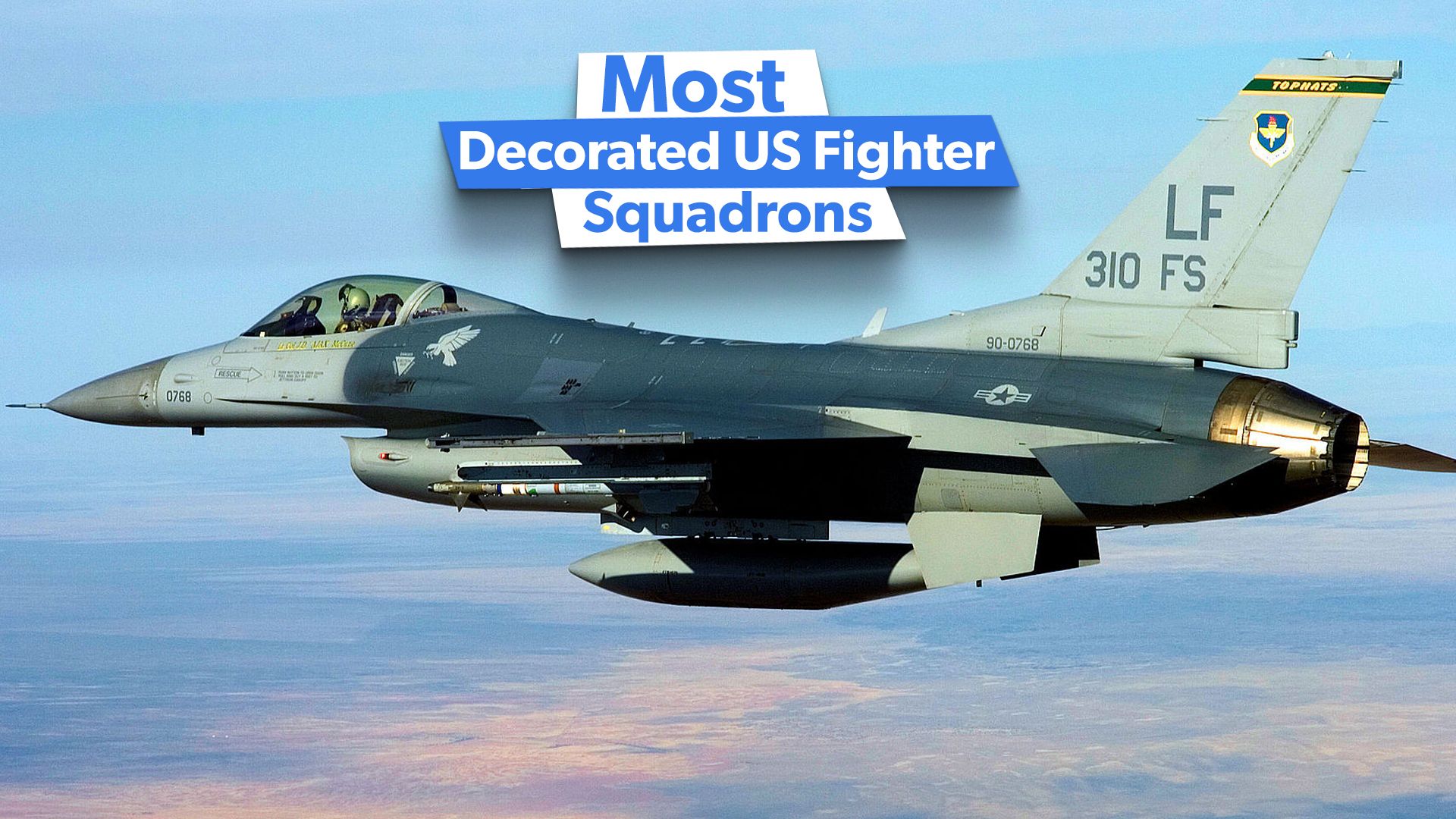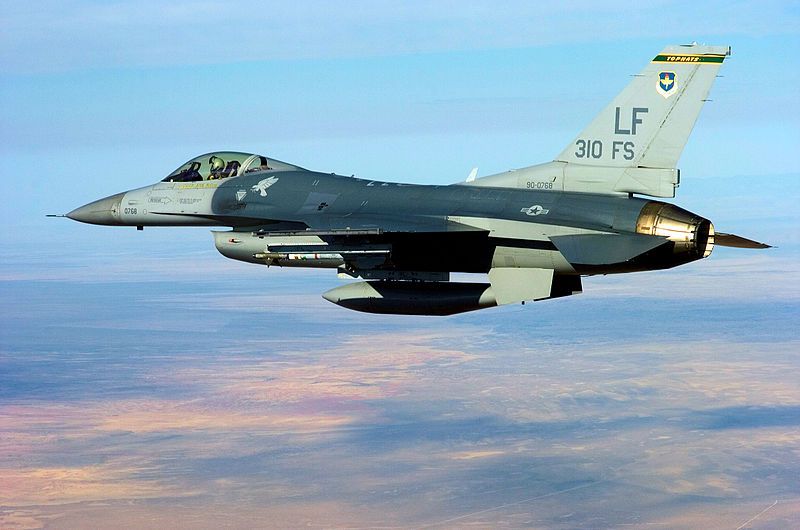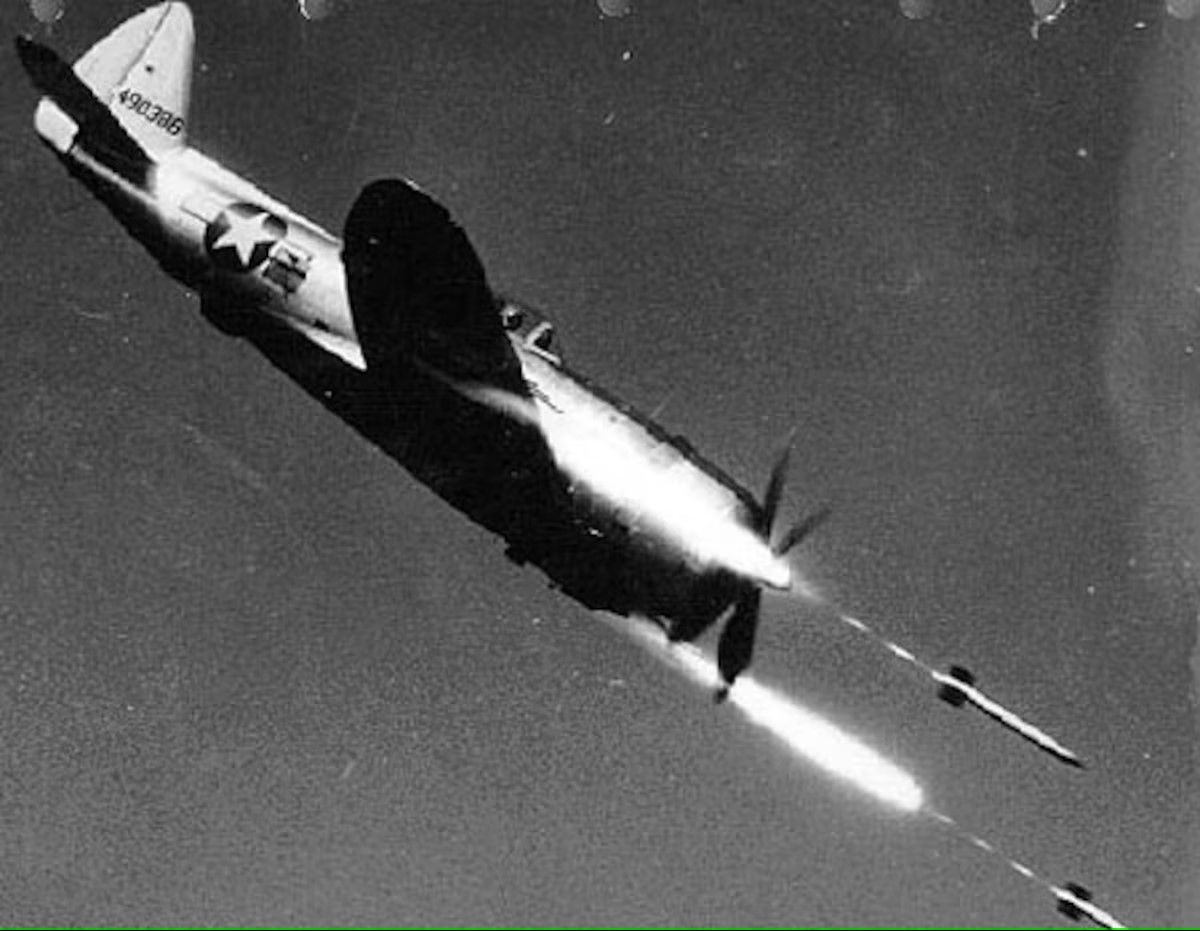Summary
- The 56th Fighter Group in WWII produced top American aces Gabreski and Johnson.
- The Flying Tigers fought with shark-nosed P-40s in WWII, destroying 296 Japanese aircraft.
- The 332nd Fighter Group, or Red Tails, by the Tuskegee Airmen, broke racial barriers in WWII.
The United States Air Force (and its predecessor, the US Army Air Forces [USAAF]), Navy, and Marine Corps, in their illustrious histories, have produced many outstanding individual fighter pilot aces and fighter pilot units going by the slogan of “One Team, One Fight.”
Simple Flying now goes beyond the exploits of individual aces (though they’ll certainly still be touched upon herein) and explores the Top 5 Most Decorated Fighter Squadrons in US History.
1
56th Fighter Group
WWII unit is known for its high number of aerial victories.
If the 56th Fighter Group sounds slightly familiar, it should. As I noted in one of my two recent standalone articles about the Republic P-47 Thunderbolt (AKA “T-Bolt, “Jug,” and “Flying Bathtub”), the 56th was the unit the top two American aces of the European Theater of World War II. Those top two aces were Col. Francis Stanley “Gabby” Gabreski (born Franciszek Stanisław Gabryszewski; January 28, 1919 – January 31, 2002) and Lt. Col. Robert Samuel “Bob” Johnson (February 21, 1920 – December 27, 1998), credited with 28 and 27 air-to-air kills respectively against Nazi Germany’s Luftwaffe.
In Bob Johnson’s autobiography “Thunderbolt!: An Extraordinary Story of a World War II Ace,” co-authored/ ghost-written by ultra-prolific aviation author Martin Caidin (September 14, 1927 – March 24, 1997)—first published in 1958—Bob was credited with 28 victories and “Gabby” with 31. However, those figures have been revised downward in recent years.
But the 56th definitely was no mere two-man show.
As noted by The Museum of Flight in Seattle, Washington:
“Under the tenacious and inspiring leadership of Colonel Hubert “Hub” Zemke, the U.S. Eighth Air Force’s 56th Fighter Group (also known as “Zemke’s Wolfpack”) emerged as one of the most successful American fighter units during World War II.”
“Flying the rugged Republic P-47 Thunderbolt and employing innovative tactics devised by Zemke, the 56th flew bomber escort and counter-air missions and supported ground troops during the invasion of France in Normandy and the Battle of the Bulge. Over roughly two years, the 56th pilots totaled 665.5 aerial victories, about 100 more victories than the second-highest fighter group in the Eighth Air Force. The 56th FG produced 39 aces.”
2
The Flying Tigers
WWII unit known for its high number of aerial victories.
Under the command of General Claire Lee Chennault, AKA “Old Leatherface” (September 6, 1893 – July 27, 1958) and tasked with taking on Imperial Japanese warplanes in defense of Generalissimo Chiang Kai-shek’s Nationalist China, they were known officially as the American Volunteer Group (AVG). Still, everybody remembers them best for their less official nickname, thanks in part to the eponymous 1942 movie starring “The Duke,” i.e., John Wayne:
Besides their nickname, the Flying Tigers were immortalized by the distinctive shark mouths that emblazoned the noses of their Curtiss P-40B Warhawks.
But the Tigers’ P-40s weren’t just a bunch of pretty faces (or, more accurately, pretty badass faces). They destroyed 296 Japanese aircraft while losing only 14 pilots in combat, thus providing some good news of tactical victories against Japan during the dark early days of the war when such victories were few and far between. What’s even more remarkable is the short space of time during which the AVG pulled off their exploits, as noted by the National Archives:
“The Flying Tigers did not see combat until December 18, 1941. On July 4, 1942, the AVG was disbanded, and many of the pilots left to return to their original military services.”
3
Red Tails (332nd Fighter Group)
The Tuskegee Airmen were known for their WWII combat achievements and for breaking racial barriers.
I’ve always found the story of the Tuskegee Airmen to be one of the best “feel-good” stories in the history of military aviation. Indeed, back when I was a USAF 2nd Lieutenant attending the Air & Space Basic Course (ASBC) at Maxwell AFB, Alabama, in April 2002, out of all the excellent guest speakers we had, a Tuskegee Airman veteran was easily the most inspirational speaker.
As noted by the National WWII Museum in New Orleans, Louisiana:
“Before the Tuskegee Airmen, no African American had ever been a United States military pilot. The Jim Crow laws, a series of racist laws that enforced the ‘separate but equal’ treatment of African Americans, were used as justification for blocking previous attempts by African American soldiers to become pilots…Between 1941 and 1946, roughly 1,000 black pilots were trained at a segregated air base in Tuskegee, AL. The Tuskegee Airmen flew hundreds of patrol and attack missions for the Twelfth Air Force, flying P-40 and P-39 airplanes, before they were reassigned to the 15th Air Force to escort B-17 and B-24 heavy bombers, using P-47 and P-51 airplanes…Bomber crews often requested to be escorted by these ‘Red Tails,’ a nicknamed [sic] acquired from the painted tails of Tuskegee fighter planes, which were a distinctive deep red.”
While 66 Tuskegee Airmen tragically died in combat, they maintained one of the lowest loss records of any escort fighter group.
“The Tuskegee Airmen achieved a number of successes during World War II. The 332nd Fighter Group was awarded the Distinguished Unit Citation for their actions on March 24, 1945. On their way to Berlin, Germany, the Red Tails destroyed three German ME-262’s. In all, the Tuskegee Airmen earned eight Purple Hearts, fourteen Bronze Stars, three Distinguished Unit Citations, and 96 Distinguished Flying Crosses.”
4
Marine Fighter Attack Squadron 232 (VMFA-232) AKA the “Red Devils”
The oldest and most decorated fighter squadron in the Marine Corps (not to be confused with the Red Tails).
You might be surprised to see this unit on the list instead of the far more renowned US Marine Corps fighter unit, VMF-214, the “Black Sheep Squadron”, under the command of then-Major (later Colonel [Ret.]) Gregory “Pappy” Boyington.
But, though less heralded and hyped up by pop culture, VMFA-232 definitely belongs on this list. These flying devil dogs (pun intended via-a-vis “Red Devils”) are the oldest and most decorated fighter squadron in the Marine Corps, serving from September 1, 1925, to November 16, 1945, and again from June 3, 1946, to the present day.
The unit didn’t start off as a pure fighter squadron; during WWII, it also flew Grumman TBF Avenger torpedo bombers and Douglas SBD Dauntless dive bombers.
During WWII, the unit lost one man killed in action (KIA) and nine men wounded in action (WIA) during the Pearl Harbor raid. It suffered another 25 enlisted Marines killed or captured during the Corps’ valiant but eventually doomed defense of Wake Island. From there, they distinguished themselves in epic battles from Guadalcanal to Bougainville to Rabaul to Okinawa.
From there, the Red Devils continued to prove their fighting mettle in the following conflicts:
Currently, VMFA-232 is part of the 3rd Marine Air Wing (3rd MAW) headquartered at Marine Corps Air Station (MCAS) Miramar, in San Diego, California and is led by:
- Lieutenant Colonel Michael D. McMahon, a prior-enlisted US Navy sailor who attained the rank of Petty Officer (pay grade E-4) before gaining acceptance to the US Naval Academy and earning his commission as a USMC 2nd Lieutenant in 2004.
- Sergeant Major Abelardo V. Dominguez, who enlisted in the USMC in June 1999 and graduated recruit training from MCRD San Diego, California that September (coincidentally the same month and year that Yours Truly enlisted in the Air Force).
5
94th Fighter Squadron
Known as the “Hat in the Ring” squadron, famous from WWI to today.
Last but not least, we have another USAF unit.
The 94th Fighter Squadron makes its home at Joint Base Langley-Eustis (formerly Langley AFB) as a unit of the 1st Operations Group. It’s a unit that wasted no time making air combat history upon its creation, as the squadron’s official history page notes:
“The 94th Fighter Squadron is one of the oldest and most decorated fighter squadrons in America’s history. It is tasked to provide Air Superiority for the United States and allied forces by engaging and destroying enemy forces, equipment, defenses or installations. The squadron operates the world’s most advanced Air Dominance fighter, the F-22A Raptor, and is ready for global deployment as part of the 1st Fighter Wing.”
“Organized as the 94th Aero Squadron at Kelly Field, Texas on 20 August 1917, the squadron began its long and prestigious history in air warfare. The 94th performed the first patrol flown by an American‑trained squadron in France during World War I, on March 6, 1918, flying the Nieuport 28. On 14 April 1918, Lieutenants Alan Winslow and Douglas Campbell each downed a German aircraft for the first aerial victories in squadron history. The 94th is also credited with the last aerial victory of the war on 10 November 1918, one day before the Armistice. With such famous members as Eddie Rickenbacker, James Meissner, and Douglas Campbell, and under the mentorship of the Lafayette Escadrille’s most lethal pilot, Raoul Lufbery, the ‘Hat‑in‑the-Ring Gang’ scored nearly 70 kills during the war, more than any other squadron, flying the Nieuport 28 and SPAD XIII.”
Appropriately enough, the unit acquired the nickname “SPADs,” and they proudly wore that moniker in WWII, during which they nabbed an additional 124 air-to-air kills against the Axis powers.
Their remarkable service endures to this day.
“16 December 2005 marked another historic day for the ‘SPADs’ with its final flight of the F‑15 as the squadron began its transition to the F-22. The 94th performed the first operational deployment of the F-22 to the CENTCOM area of responsibility in 2011. They continue to demonstrate Air Superiority and lethality over Iraq and Syria in the fight against ISIS, recently completing the first combat employment of the Small Diameter Bomb from an F-22. Today, the “Hat‑in‑the‑Ring” stands as a cohesive combat-experienced team ready for any call to support our nation’s security requirements.”
Bravo Zulu. SPADS/Hat-in-the-Ring!




